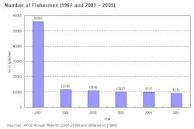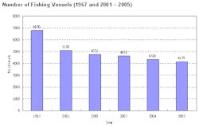Fisheries Baseline
Historical Overview of Hong Kong Capture Fisheries
From the second half of the 20th century the local commercial fishing industry has experienced
various transitions. Government loans in the 1950s enabled rapid growth in fleet size and fishing
effort and, with improvements in fishing equipment, by the 1960s there had been a substantial
increase in the size of the capture fisheries industry. The catch per unit effort for trawlers at this
time was ~90-140 kg per haul.
By the 1970s the decline of the industry was becoming apparent, with smaller pelagic fish such as
sardines the dominant catch and the catch per unit effort showing signs of decline. In the 1980s
species such as groupers and croakers had become uncommon catches and a general decline in
the finfish catch was observed, with the trawler catch per unit effort having fallen to ~15 kg per haul
(ibid). Through the 1990s the average trawler catch was ~10 kg with juvenile fish comprising most
of the catch.
By the end of the 1990s the local catch of fishes and invertebrates had declined significantly over
the prior 50 years, with an estimated 80% decline in fish biomass over this period. The continued
decline in the local capture fisheries industry in more recent years is reflected by the decrease in
fishing vessels and fishermen.
Capture Fisheries in the Study Area
AFCD Port Survey data consistently suggests there is little fishing activity in offshore waters,
although the Port Survey 2006 data notably suggests an increase in larger vessels activity in the
vicinity of the proposed wind farm relative to both earlier Port Surveys (i.e., “Negligible / Very Low”
(1996/97), “Very Low” (2001/02) and “Very Low / Moderate” (2006)).
Port Survey 2006 data also suggests that fishing activity by small and large vessels alike in all
areas of offshore Eastern Waters (north and south) except near the proposed wind farm remains
“Negligible / Very Low”. There is no apparent reason for this suggested increase in offshore
fishing activity specifically near the proposed wind farm.
The Port Survey data from 2001/02 and 2006 suggests that overall dollar catch value and adult fish
productivity is consistently high around the Ninepin Islands and consistently low in waters further
offshore, including the location of the proposed wind farm. Adult fish productivity along the cable
route and at Tung Lung Chau is somewhat variable, possibly reflecting differences in fishing
practice and specific location.
All three Port Survey studies indicate that Eastern Waters has negligible or very low fish fry
productivity,
Mariculture Zones in the Study Area
There are currently 1,080 licensed mariculture operators across 26 fish culture zones in the
HKSAR, with these zones collectively occupying a surface area of ~209 hectares. Nine of the 26
fish culture zones are located in the vicinity of the Study Area.
Historical Overview of Hong Kong Capture Fisheries
From the second half of the 20th century the local commercial fishing industry has experienced
various transitions. Government loans in the 1950s enabled rapid growth in fleet size and fishing
effort and, with improvements in fishing equipment, by the 1960s there had been a substantial
increase in the size of the capture fisheries industry. The catch per unit effort for trawlers at this
time was ~90-140 kg per haul.
By the 1970s the decline of the industry was becoming apparent, with smaller pelagic fish such as
sardines the dominant catch and the catch per unit effort showing signs of decline. In the 1980s
species such as groupers and croakers had become uncommon catches and a general decline in
the finfish catch was observed, with the trawler catch per unit effort having fallen to ~15 kg per haul
(ibid). Through the 1990s the average trawler catch was ~10 kg with juvenile fish comprising most
of the catch.
By the end of the 1990s the local catch of fishes and invertebrates had declined significantly over
the prior 50 years, with an estimated 80% decline in fish biomass over this period. The continued
decline in the local capture fisheries industry in more recent years is reflected by the decrease in
fishing vessels and fishermen.
Capture Fisheries in the Study Area
AFCD Port Survey data consistently suggests there is little fishing activity in offshore waters,
although the Port Survey 2006 data notably suggests an increase in larger vessels activity in the
vicinity of the proposed wind farm relative to both earlier Port Surveys (i.e., “Negligible / Very Low”
(1996/97), “Very Low” (2001/02) and “Very Low / Moderate” (2006)).
Port Survey 2006 data also suggests that fishing activity by small and large vessels alike in all
areas of offshore Eastern Waters (north and south) except near the proposed wind farm remains
“Negligible / Very Low”. There is no apparent reason for this suggested increase in offshore
fishing activity specifically near the proposed wind farm.
The Port Survey data from 2001/02 and 2006 suggests that overall dollar catch value and adult fish
productivity is consistently high around the Ninepin Islands and consistently low in waters further
offshore, including the location of the proposed wind farm. Adult fish productivity along the cable
route and at Tung Lung Chau is somewhat variable, possibly reflecting differences in fishing
practice and specific location.
All three Port Survey studies indicate that Eastern Waters has negligible or very low fish fry
productivity,
Mariculture Zones in the Study Area
There are currently 1,080 licensed mariculture operators across 26 fish culture zones in the
HKSAR, with these zones collectively occupying a surface area of ~209 hectares. Nine of the 26
fish culture zones are located in the vicinity of the Study Area.




